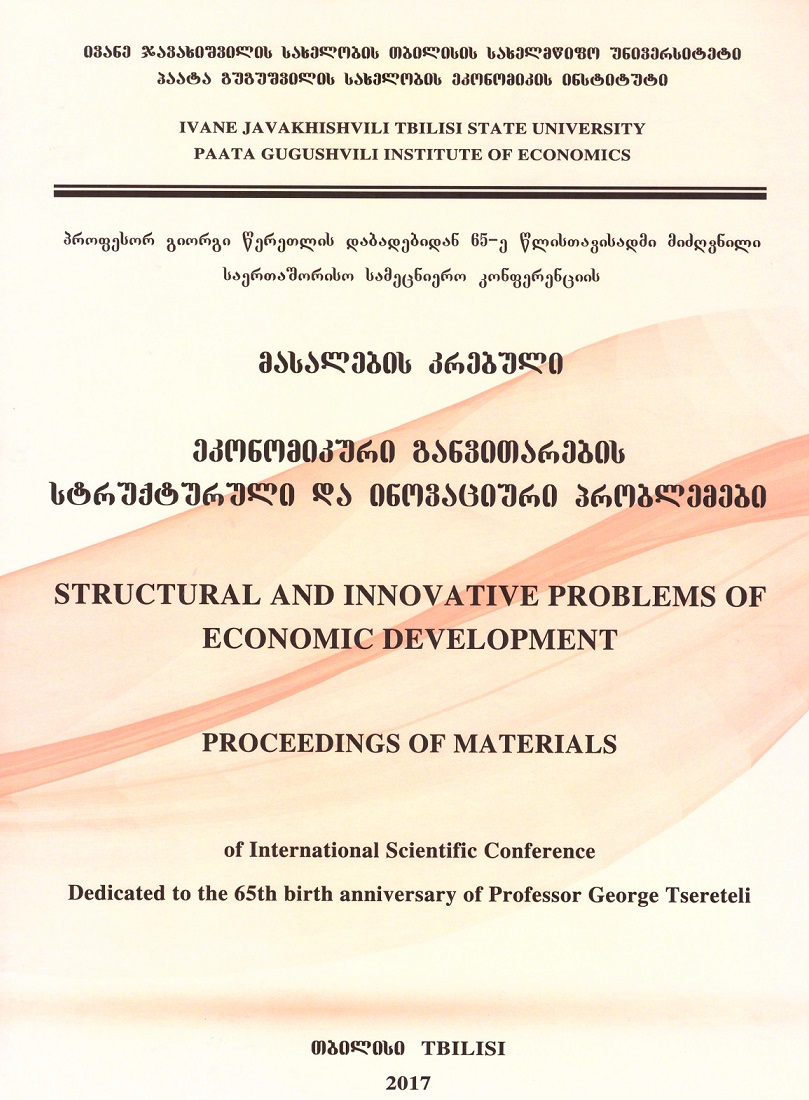
Ivane Javakhishvili Tbilisi State University
Paata Gugushvili Institute of Economics International Scientific

DEDOLLARIZATION: INTERNATIONAL PRACTICE AND EXPERIENCE
Annotation.Since the restoration of Georgia's independence, the Georgian currency has been the main symbol of Georgia's economic independence. Despite this, over the past 35 years, the currency has not been fully used, which is due to the real lack of one of the functions of money - storage, that is, the factor of trust in it. The article reviews the larization program that began in 2016 and international experience.
Keywords:Dedolarization, Lari, Function of money, currency, convertibility.
At the end of 2016, a number of initiatives were announced and implemented in the economy and financial market at the initiative of the Georgian government. The goal of these measures was and is to reduce the impact of external shocks and stimulate the economic development of the domestic market. As well as to mitigate a number of acute local imbalances that concern many of our citizens.
Currently, we are considering only one aspect, the implementation of which was entrusted to the National Bank of Georgia and was initially called the international equivalent - dedollarization, and after some dissonance and dissatisfaction in society, its second name - larization - became more established in Georgia.
It should be noted that the implementation of the above-mentioned measure (dedollarization - larization) is not a Georgian novelty and has been carried out and is being carried out in many countries at different times and in different historical periods. In this regard, we will try to review this international experience and the goal that accompanies this program in the financial market.
What is the goal of larization, or dedollarization in international terminology? - In the financial sector (primarily in commercial banks), the share of resources attracted in foreign currency is reduced and the share of resources attracted in local currency is increased.
In other words, simply - the share of deposits in GEL is increased, loans are issued in GEL, and the function of GEL as a full-fledged currency is strengthened (the optimal goal is to carry out all operations in GEL, strengthen GEL as a measure of value, and use GEL as a means of accumulation).
Based on the analysis of authoritative international organizations (the International Monetary Fund, the World Bank, etc.), research by well-known scientists, and analytical publications, and as a result of studying the essence of the problem, we conclude that during the period 1980-2010, up to 100 countries resorted to de-dollarization (i.e., reducing the share of foreign global currencies in the financial sector and increasing the share of local currencies).
Unfortunately, according to their research, successful de-dollarization is more the exception than the norm, and only four cases turned out to be successful. Successful examples are Israel, Mexico, Pakistan, and Poland.
Of the successful four, we considered Poland to be the closest to the reality and reality of Georgia, and we will briefly introduce you to its initial situation and current reality.
Before the de-dollarization measure was implemented, Poland, like Georgia, went through the unstable 80s and 90s, with a large fiscal deficit and hyperinflation, as a result of which the Polish population lost confidence in the Polish currency - the zloty - and all payments and savings were made only in dollars or euros. Dollarization reached 80%.
As a result of government policy and especially the effective and efficient measures of the Central Bank of Poland, this indicator was almost halved, and now the Polish zloty is a convertible, solid and reliable currency, foreign direct investment flows to Poland in a continuous flow of multi-billion dollars, which resulted in Poland's high economic growth in 1995-2020 and a noticeable improvement in the well-being of the population.
What contributed to the successful de-dollarization in Poland and Israel? (i.e. what will help the larization program to be successful?):
1. Inflation control program - cessation of money emission, prohibition of any indirect emission (including the so-called refinancing pyramid), which at the initial stage is expressed in the increase in the price of local currency loans and the increase in interest accrued on deposits;
2. The example of Poland showed that the success was facilitated by the orientation of Polish banks mainly to the domestic market - that is, they became less dependent and even partially isolated from foreign financial markets;
3. In the Polish commercial banking system, banking and non-banking services are separated - that is, commercial banks and their affiliated structures are not widely involved in non-core activities;
4. The creditworthiness of the system has been strengthened by the long-term commitment of foreign shareholders, who consider investments in Poland to be strategic and continue to share knowledge, improve infrastructure and diversify banking products.
As we can see, the reality in Georgia is still different, which leaves the success of the larization program in the long term.
Georgia faces additional problems on the path to larization:
1. High external debt;
2. Weak exports and strong imports;
3. Unstable channels of domestic and foreign investment inflow
According to IMF experts, the size of external debt relative to GDP directly affects the success of de-dollarization.
According to IMF study, conducted within the period of 2008 – 2024, the success of fiscal policy and de-dollarization is high in developing countries where the amount of government debt in relation to GDP does not exceed 25 percent, while in developed countries (Poland, the Czech Republic, South Korea, etc.) it is no more than 60-75 percent.
The reason for this is simple (which has been confirmed by research) - if the amount of debt is high - the created deficit in the country's economy.
Georgia belongs to the category of developing countries and the volume of public debt is within 40 percent of GDP. At the same time, during the pandemic, it exceeded 60 percent.
In this regard, a sharp reduction of this indicator (to at least 25 percent) is necessary, which is possible only by encouraging domestic investment, encouraging foreign direct investment and debt repayment, and increasing the scale of the Georgian economy (GDP growth - annual high or double-digit economic growth), which will reduce this disproportion over the years.
(The article does not discuss the large-scale disproportion existing in the Georgian economy - growing profitability in non-productive - intermediary businesses and the actual regression of the real economy, which cannot be overcome without political will and relevant and real legislative changes).
Literature
- David Aslanishvili. (2024). Process of economic reforms in Georgia and the Shock Therapy (1991 – 1998). Progress in Science, (7). Retrieved from https://ojs.scipub.de/index.php/PS/article/view/4241
- David Aslanishvili. (2024). Georgian Treasury Bills Market – first steps and discovered problems (1997 – 1999). European Research Materials, (7). Retrieved from https://ojs.scipub.de/index.php/ERM/article/view/4202
- David Aslanishvili. (2024). Georgian Economy retrospective: from the Soviet Planning time to the transition. Foundations and Trends in Research, (7). Retrieved from https://ojs.scipub.de/index.php/FTR/article/view/4159
- Aslanishvili, D. (2025). Georgian Economy, Energy, Foreign Trade and The Balance of Payments in 90-s: Problems and Solution. Scientific Results,(10).
- David Aslanishvili. (2025). Georgia of 1991 -1999: The first signs of the Economic Sovereignty and an Economic Safety. Modern Scientific Technology, (10). Retrieved from https://ojs.scipub.de/index.php/MSC/article/view/6330
- Davit Aslanishvili. (2025). Observation of Georgia’s Macroeconomic Policy of late 90-s as the Grounding of the Country’s Economic Advance. Modern Scientific Method, (10). Retrieved from https://ojs.scipub.de/index.php/MSM/article/view/6456
- David Aslanishvili. (2025). Georgia of 1991 -1999: The first signs of the Economic Sovereignty and an Economic Safety. Modern Scientific Technology, (10). Retrieved from https://ojs.scipub.de/index.php/MSC/article/view/6330
- Aslanishvili, D., & Omadze, K. (2023). THE EVOLUTION OF THE ESSENCE OF HUMAN MATERIAL LIFE–FROM ANCIENT ROME TO THE MODERN WORLD. THE PROBLEMS OF DEVELOPMENT OF THE WORLD AND NATIONAL ECONOMY, TAKING INTO ACCOUNT THE PANDEMIC AND RUSSIAN-UKRAINIAN WAR PERSPECTIVES, 14.
- Aslanishvili, D., & Omadze, K. (2016). Origins and the Reasons of Monetary Crises in Georgia (1995-2016). Modern Economy, 7(11), 1232-1250.
- Aslanishvili, D. (2016). Market foundation for sustainable economy growth and energy policy (Georgian case). Modern Economy, 7(03), 314-319.
- Aslanishvili, D., & Omadze, K. THE INFLUENCE OF GLOBAL ECONOMIC CRISIS ON WORLD ECONOMY, ITS REASONS AND OVERCOME STEPS. In Materials of reports made at the international scientific-practical conference held at Paata Gugushvili Institute of Economics of Ivane Javakhishvili Tbilisi State University in 2013 (p. 508).
- Aslanishvili, D. D. (2021). World Experience: Commercial Bank Credit and Economic Growth Relationship. International Journal of Risk and Contingency Management (IJRCM), 10(1), 45-53. http://doi.org/10.4018/IJRCM.2021010105
- Aslanishvili, D., & Omadze, K. (2013). The Impact of the Economic Crisis on the World Economy–TSU. International Scientific-Practical Conference of the Institute of Economics (pp. 28-29).
- Aslanishvili, D. (2015). Georgian Eurobond: Unknown Reasons of Issue. In Materials of reports made at the international scientific-practical conference held at Paata Gugushvili Institute of Economics of Ivane Javakhishvili Tbilisi State University in 2015 (p. 317).
- Aslanishvili, D. . (2021). Georgia state debts as securitization example. Georgian Scientists, 1(1). https://doi.org/10.52340/gs.02.09.225
- Aslanishvili, D. Ricardo equivalent, the origin of state debt, its meaning and practical purpose Conference: Modern Tendencies of Development of Economy and Economic Science.
